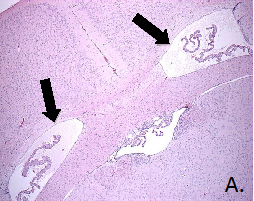
Etiology: Congenital hydrocephalus is associated with some mutations and transgenes [8]. The cause is unknown.
Incidence: Hydrocephalus is commonly seen as a background lesion in C57BL/6J mice.
Clinical signs: Hydrocephalus is evident in young animals before the cranial sutures close. Mice have enlarged, domed heads and are ataxic and depressed. Neural tissue damage may result in the eventual death of the animal. Adult animals do not present with a domed skull but may be ataxic and/or depressed [8].
Pathology: On histologic evaluation of brain cross sections, there is evidence of dilated ventricles, particularly the lateral ventricles (A., arrows).
Diagnosis: Diagnosis is based on gross and microscopic examination of the head and brain.
8. Hydrocephalus in Laboratory Mice. JAX Notes, 2003.